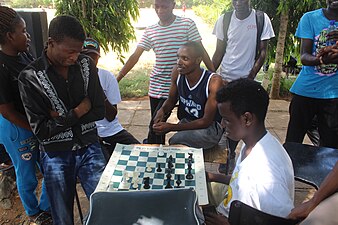
A | B | C | D | E | F | G | H | CH | I | J | K | L | M | N | O | P | Q | R | S | T | U | V | W | X | Y | Z | 0 | 1 | 2 | 3 | 4 | 5 | 6 | 7 | 8 | 9
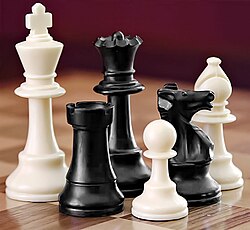 | |
| Years active | c. 1475 to present[1] (predecessors c. 900 years earlier) |
|---|---|
| Genres | |
| Players | 2 |
| Chance | None |
| Skills | Strategy, tactics |
| Synonyms |
|
Chess is a board game for two players, called White and Black, each controlling an army of chess pieces, with the objective to checkmate the opponent's king. It is sometimes called international chess or Western chess to distinguish it from related games such as xiangqi (Chinese chess) and shogi (Japanese chess). The recorded history of chess goes back at least to the emergence of a similar game, chaturanga, in seventh-century India. The rules of chess as they are known today emerged in Europe at the end of the 15th century, with standardization and universal acceptance by the end of the 19th century. Today, chess is one of the world's most popular games, and is played by millions of people worldwide.
Chess is an abstract strategy game that involves no hidden information and no elements of chance. It is played on a chessboard with 64 squares arranged in an 8×8 grid. At the start, each player controls sixteen pieces: one king, one queen, two rooks, two bishops, two knights, and eight pawns. White moves first, followed by Black. The game is won by checkmating the opponent's king, i.e. threatening it with inescapable capture. There are also several ways a game can end in a draw.
Organized chess arose in the 19th century. Chess competition today is governed internationally by FIDE (Fédération Internationale des Échecs; the International Chess Federation). The first universally recognized World Chess Champion, Wilhelm Steinitz, claimed his title in 1886; Ding Liren is the current World Champion. A huge body of chess theory has developed since the game's inception. Aspects of art are found in chess composition, and chess in its turn influenced Western culture and the arts, and has connections with other fields such as mathematics, computer science, and psychology.
One of the goals of early computer scientists was to create a chess-playing machine. In 1997, Deep Blue became the first computer to beat the reigning World Champion in a match when it defeated Garry Kasparov. Today's chess engines are significantly stronger than the best human players and have deeply influenced the development of chess theory; however, chess is not a solved game.
Rules
The rules of chess are published by FIDE (Fédération Internationale des Échecs; "International Chess Federation"), chess's world governing body, in its Handbook.[2] Rules published by national governing bodies, or by unaffiliated chess organizations, commercial publishers, etc., may differ in some details. FIDE's rules were most recently revised in 2023.
Setup
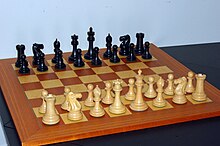
Chess sets come in a wide variety of styles. The Staunton pattern is the most common, and is usually required for competition. Chess pieces are divided into two sets, usually light and dark colored, referred to as white and black, regardless of the actual color or design. The players of the sets are referred to as White and Black, respectively. Each set consists of sixteen pieces: one king, one queen, two rooks, two bishops, two knights, and eight pawns.
The game is played on a square board of eight rows (called ranks) and eight columns (called files). By convention, the 64 squares alternate in color and are referred to as light and dark squares; common colors for chessboards are white and brown, or white and green.
| a | b | c | d | e | f | g | h | ||
| 8 |  | 8 | |||||||
| 7 | 7 | ||||||||
| 6 | 6 | ||||||||
| 5 | 5 | ||||||||
| 4 | 4 | ||||||||
| 3 | 3 | ||||||||
| 2 | 2 | ||||||||
| 1 | 1 | ||||||||
| a | b | c | d | e | f | g | h | ||
The pieces are set out as shown in the diagram and photo. Thus, on White's first rank, from left to right, the pieces are placed as follows: rook, knight, bishop, queen, king, bishop, knight, rook. Eight pawns are placed on the second rank. Black's position mirrors White's, with an equivalent piece on the same file. The board is placed with a light square at the right-hand corner nearest to each player. The correct position of the light square may be remembered by the phrase "light on right", while the correct positions of the king and queen may be remembered by the phrase "queen on her own color" (i.e. the white queen begins on a light square, and the black queen on a dark square).
In competitive games, the piece colors are allocated to players by the organizers; in informal games, the colors are usually decided randomly, for example by a coin toss, or by one player concealing a white pawn in one hand and a black pawn in the other, and having the opponent choose.
Movement
White moves first, after which players alternate turns, moving one piece per turn (except for castling, when two pieces are moved). A piece is moved to either an unoccupied square or one occupied by an opponent's piece, which is captured and removed from play. With the sole exception of en passant, all pieces capture by moving to the square that the opponent's piece occupies. Moving is compulsory; a player may not skip a turn, even when having to move is detrimental.
Each piece has its own way of moving. In the diagrams, crosses mark the squares to which the piece can move if there are no intervening piece(s) of either color (except the knight, which leaps over any intervening pieces). All pieces except the pawn can capture an enemy piece if it is on a square to which they could move if the square were unoccupied. Pieces are generally not permitted to move through squares occupied by pieces of either color, except for the knight and during castling.
|
Moves of the king
|
Moves of a rook
|
Moves of a bishop
| ||||||||||||||||||||||||||||||||||||||||||||||||||||||||||||||||||||||||||||||||||||||||||||||||||||||||||||||||||||||||||||||||||||
|
Moves of a queen
|
Moves of a knight
|
Moves of a pawn
| ||||||||||||||||||||||||||||||||||||||||||||||||||||||||||||||||||||||||||||||||||||||||||||||||||||||||||||||||||||||||||||||||||||
- The king moves one square in any direction. There is also a special move called castling that involves moving the king and a rook. The king is the most valuable piece—attacks on the king must be immediately countered, and if this is impossible, the game is immediately lost (see Check and checkmate below).
- A rook can move any number of squares along a rank or file, but cannot leap over other pieces. Along with the king, a rook is involved during the king's castling move.
- A bishop can move any number of squares diagonally, but cannot leap over other pieces.
- A queen combines the power of a rook and bishop and can move any number of squares along a rank, file, or diagonal, but cannot leap over other pieces.
- A knight moves to any of the closest squares that are not on the same rank, file, or diagonal. (Thus the move forms an "L"-shape: two squares vertically and one square horizontally, or two squares horizontally and one square vertically.) The knight is the only piece that can leap over other pieces.
- A pawn can move forward to the unoccupied square immediately in front of it on the same file, or on its first move it can advance two squares along the same file, provided both squares are unoccupied (black dots in the diagram). A pawn can capture an opponent's piece on a square diagonally in front of it by moving to that square (black crosses). It cannot capture a piece while advancing along the same file. A pawn has two special moves: the en passant capture and promotion.
Check and checkmate
When a king is under immediate attack, it is said to be in check. A move in response to a check is legal only if it results in a position where the king is no longer in check. There are three ways to counter a check:
- Capture the checking piece.
- Interpose a piece between the checking piece and the king (which is possible only if the attacking piece is a queen, rook, or bishop and there is a square between it and the king).
- Move the king to a square where it is not under attack.
Castling is not a permissible response to a check.[2]
The object of the game is to checkmate the opponent; this occurs when the opponent's king is in check, and there is no legal way to get it out of check. It is never legal for a player to make a move that puts or leaves the player's own king in check. In casual games, it is common to announce "check" when putting the opponent's king in check, but this is not required by the rules of chess and is usually not done in tournaments.[3]
The black king is in check by the rook.
|
White is in checkmate, being unable to escape attack by the bishop on f3.
| ||||||||||||||||||||||||||||||||||||||||||||||||||||||||||||||||||||||||||||||||||||||||
Castling
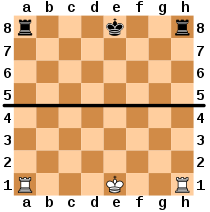
Once per game, each king can make a move known as castling. Castling consists of moving the king two squares toward a rook of the same color on the same rank, and then placing the rook on the square that the king crossed.
Castling is permissible if the following conditions are met:[2]
- Neither the king nor the rook has previously moved during the game.
- There are no pieces between the king and the rook.
- The king is not in check and does not pass through or finish on a square attacked by an enemy piece.
Castling is still permitted if the rook is under attack, or if the rook crosses an attacked square.
En passant
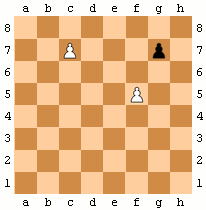
(left) promotion; (right) en passant
When a pawn makes a two-step advance from its starting position and there is an opponent's pawn on a square next to the destination square on an adjacent file, then the opponent's pawn can capture it en passant ("in passing"), moving to the square the pawn passed over. This can be done only on the turn immediately following the enemy pawn's two-square advance; otherwise, the right to do so is forfeited. For example, in the animated diagram, the black pawn advances two squares from g7 to g5, and the white pawn on f5 can take it en passant on g6 (but only immediately after the black pawn's advance).
Promotion
When a pawn advances to its eighth rank, as part of the move, it is promoted and must be exchanged for the player's choice of queen, rook, bishop, or knight of the same color. Usually, the pawn is chosen to be promoted to a queen, but in some cases, another piece is chosen; this is called underpromotion. In the animated diagram, the pawn on c7 can be advanced to the eighth rank and be promoted. There is no restriction on the piece promoted to, so it is possible to have more pieces of the same type than at the start of the game (e.g., two or more queens). If the required piece is not available (e.g. a second queen) an inverted rook is sometimes used as a substitute, but this is not recognized in FIDE-sanctioned games.
End of the game
Win
A game can be won in the following ways:
- Checkmate: The opposing king is in check and the opponent has no legal move. (See check and checkmate above.)
- Resignation: A player may resign, conceding the game to the opponent.[4] If, however, the opponent has no way of checkmating the resigned player, this is a draw under FIDE Laws.[2] Most tournament players consider it good etiquette to resign in a hopeless position.[5][6]
- Win on time: In games with a time control, a player wins if the opponent runs out of time, even if the opponent has a superior position, as long as the player has a theoretical possibility to checkmate the opponent were the game to continue.
- Forfeit: A player who cheats, violates the rules, or violates the rules of conduct specified for the particular tournament can be forfeited. Occasionally, both players are forfeited.[2]
Draw
There are several ways a game can end in a draw:
- Stalemate: If the player to move has no legal move, but is not in check, the position is a stalemate, and the game is drawn.
- Dead position: If neither player is able to checkmate the other by any legal sequence of moves, the game is drawn. For example, if only the kings are on the board, all other pieces having been captured, checkmate is impossible, and the game is drawn by this rule. On the other hand, if both players still have a knight, there is a highly unlikely yet theoretical possibility of checkmate, so this rule does not apply. The dead position rule supersedes the previous rule which referred to "insufficient material", extending it to include other positions where checkmate is impossible, such as blocked pawn endings where the pawns cannot be attacked.
- Draw by agreement: In tournament chess, draws are most commonly reached by mutual agreement between the players. The correct procedure is to verbally offer the draw, make a move, then start the opponent's clock. Traditionally, players have been allowed to agree to a draw at any point in the game, occasionally even without playing a move. More recently efforts have been made to discourage short draws, for example by forbidding draw offers before move thirty.
- Threefold repetition: This most commonly occurs when neither side is able to avoid repeating moves without incurring a disadvantage. In this situation, either player can claim a draw; this requires the players to keep a valid written record of the game so that the claim can be verified by the arbiter if challenged. The three occurrences of the position need not occur on consecutive moves for a claim to be valid. The addition of the fivefold repetition rule in 2014 requires the arbiter to intervene immediately and declare the game a draw after five occurrences of the same position, consecutive or otherwise, without requiring a claim by either player. FIDE rules make no mention of perpetual check; this is merely a specific type of draw by threefold repetition.
- Fifty-move rule: If during the previous 50 moves no pawn has been moved and no capture has been made, either player can claim a draw. The addition of the seventy-five-move rule in 2014 requires the arbiter to intervene and immediately declare the game drawn after 75 moves without a pawn move or capture, without requiring a claim by either player. There are several known endgames where it is possible to force a mate but it requires more than 50 moves before a pawn move or capture is made; examples include some endgames with two knights against a pawn and some pawnless endgames such as queen against two bishops. Historically, FIDE has sometimes revised the fifty-move rule to make exceptions for these endgames, but these have since been repealed. Some correspondence chess organizations do not enforce the fifty-move rule.[note 1]
- Draw on time: In games with a time control, the game is drawn if a player is out of time and no sequence of legal moves would allow the opponent to checkmate the player.[2]
- Draw by resignation: Under FIDE Laws, a game is drawn if a player resigns and no sequence of legal moves would allow the opponent to checkmate that player.[2]
Black (to move) is not in check and has no legal move. The result is stalemate.
|
A dead position; White's king and bishop are insufficient to checkmate.
|
Also a dead position; neither king can capture the other's pawns in order to promote a pawn and give checkmate.
| ||||||||||||||||||||||||||||||||||||||||||||||||||||||||||||||||||||||||||||||||||||||||||||||||||||||||||||||||||||||||||||||||||||
Time control

In competition, chess games are played with a time control. If a player's time runs out before the game is completed, the game is automatically lost (provided the opponent has enough pieces left to deliver checkmate).[2] The duration of a game ranges from long (or "classical") games, which can take up to seven hours (even longer if adjournments are permitted), to bullet chess (under 3 minutes per player for the entire game). Intermediate between these are rapid chess games, lasting between one and two hours per game, a popular time control in amateur weekend tournaments.
Time is controlled using a chess clock that has two displays, one for each player's remaining time. Analog chess clocks have been largely replaced by digital clocks, which allow for time controls with increments.
Time controls are also enforced in correspondence chess competitions. A typical time control is 50 days for every 10 moves.
Notation
Historically, many different notation systems have been used to record chess moves; the standard system today is short-form algebraic notation.[8] In this system, each square is uniquely identified by a set of coordinates, a–h for the files followed by 1–8 for the ranks. The usual format is
- initial of the piece moved – file of destination square – rank of destination square
The pieces are identified by their initials. In English, these are K (king), Q (queen), R (rook), B (bishop), and N (knight; N is used to avoid confusion with king). For example, Qg5 means "queen moves to the g-file, 5th rank" (that is, to the square g5). Different initials may be used for other languages. In chess literature, figurine algebraic notation (FAN) is frequently used to aid understanding independent of language.
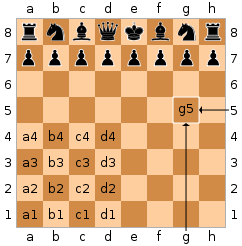
To resolve ambiguities, an additional letter or number is added to indicate the file or rank from which the piece moved (e.g. Ngf3 means "knight from the g-file moves to the square f3"; R1e2 means "rook on the first rank moves to e2"). For pawns, no letter initial is used; so e4 means "pawn moves to the square e4".
If the piece makes a capture, "x" is usually inserted before the destination square. Thus Bxf3 means "bishop captures on f3". When a pawn makes a capture, the file from which the pawn departed is used to identify the pawn making the capture, for example, exd5 (pawn on the e-file captures the piece on d5). Ranks may be omitted if unambiguous, for example, exd (pawn on the e-file captures a piece somewhere on the d-file). A minority of publications use ":" to indicate a capture, and some omit the capture symbol altogether. In its most abbreviated form, exd5 may be rendered simply as ed. An en passant capture may optionally be marked with the notation "e.p."
If a pawn moves to its last rank, achieving promotion, the piece chosen is indicated after the move (for example, e1=Q or e1Q). Castling is indicated by the special notations 0-0 (or O-O) for kingside castling and 0-0-0 (or O-O-O) for queenside castling. A move that places the opponent's king in check usually has the notation "+" added. There are no specific notations for discovered check or double check. Checkmate can be indicated by "#". At the end of the game, "1–0" means White won, "0–1" means Black won, and "½–½" indicates a draw.[2] Chess moves can be annotated with punctuation marks and other symbols. For example: "!" indicates a good move; "!!" an excellent move; "?" a mistake; "??" a blunder; "!?" an interesting move that may not be best; or "?!" a dubious move not easily refuted.[9]
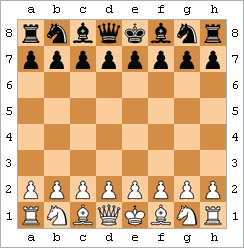
For example, one variation of a simple trap known as the Scholar's mate (see animated diagram) can be recorded:
Variants of algebraic notation include long algebraic, in which both the departure and destination square are indicated; abbreviated algebraic, in which capture signs, check signs, and ranks of pawn captures may be omitted; and Figurine Algebraic Notation, used in chess publications for universal readability regardless of language.
Portable Game Notation (PGN) is a text-based file format for recording chess games, based on short form English algebraic notation with a small amount of markup. PGN files (suffix .pgn) can be processed by most chess software, as well as being easily readable by humans.
Until about 1980, the majority of English language chess publications used descriptive notation, in which files are identified by the initial letter of the piece that occupies the first rank at the beginning of the game. In descriptive notation, the common opening move 1.e4 is rendered as "1.P-K4" ("pawn to king four"). Another system is ICCF numeric notation, recognized by the International Correspondence Chess Federation though its use is in decline.
In tournament games, players are normally required to keep a score (record of the game). For this purpose, only algebraic notation is recognized in FIDE-sanctioned events; game scores recorded in a different notation system may not be used as evidence in the event of a dispute.
Chess in public spaces
Chess is often played casually in public spaces such as parks and town squares.
-
Public chess tables in the Jardin du Luxembourg, Paris
-
Men playing chess, Kutaisi, Georgia, 2014
-
A girl playing chess in Mexico City.
-
Chess game in Kilifi, Kenya
-
Giant chess on Cathedral Square, Christchurch, New Zealand.
-
On a street of Santiago de Cuba.
-
Chess players in the Széchenyi baths of Budapest, Hungary.
-
A girl playing chess in Salatiga, Indonesia.
Organized competition
Tournaments and matches
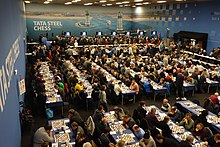
Contemporary chess is an organized sport with structured international and national leagues, tournaments, and congresses. Thousands of chess tournaments, matches, and festivals are held around the world every year catering to players of all levels.
Tournaments with a small number of players may use the round-robin format, in which every player plays one game against every other player. For a large number of players, the Swiss system may be used, in which each player is paired against an opponent who has the same (or as similar as possible) score in each round. In either case, a player's score is usually calculated as 1 point for each game won and one-half point for each game drawn. Variations such as "football scoring" (3 points for a win, 1 point for a draw) may be used by tournament organizers, but ratings are always calculated on the basis of standard scoring. A player's score may be reported as total score out of games played (e.g. 5½/8), points for versus points against (e.g. 5½–2½), or by number of wins, losses and draws (e.g. +4−1=3).
The term "match" refers not to an individual game, but to either a series of games between two players, or a team competition in which each player of one team plays one game against a player of the other team.
Governance
Chess's international governing body is usually known by its French acronym FIDE (pronounced FEE-day) (French: Fédération internationale des échecs), or International Chess Federation. FIDE's membership consists of the national chess organizations of over 180 countries; there are also several associate members, including various supra-national organizations, the International Braille Chess Association (IBCA), International Committee of Chess for the Deaf (ICCD), and the International Physically Disabled Chess Association (IPCA).[10] FIDE is recognized as a sports governing body by the International Olympic Committee,[11] but chess has never been part of the Olympic Games.

FIDE's most visible activity is organizing the World Chess Championship, a role it assumed in 1948. The current World Champion is Ding Liren of China.[12] The reigning Women's World Champion is Ju Wenjun from China.[13]
Other competitions for individuals include the World Junior Chess Championship, the European Individual Chess Championship, the tournaments for the World Championship qualification cycle, and the various national championships. Invitation-only tournaments regularly attract the world's strongest players. Examples include Spain's Linares event, Monte Carlo's Melody Amber tournament, the Dortmund Sparkassen meeting, Sofia's M-tel Masters, and Wijk aan Zee's Tata Steel tournament.
Regular team chess events include the Chess Olympiad and the European Team Chess Championship.
The World Chess Solving Championship and World Correspondence Chess Championships include both team and individual events; these are held independently of FIDE.
Titles and rankings
In order to rank players, FIDE, ICCF, and most national chess organizations use the Elo rating system developed by Arpad Elo. An average club player has a rating of about 1500; the highest FIDE rating of all time, 2882, was achieved by Magnus Carlsen on the March 2014 FIDE rating list.[14]
Players may be awarded lifetime titles by FIDE:[16]
- Grandmaster (GM; sometimes International Grandmaster or IGM is used) is awarded to world-class chess masters. Apart from World Champion, Grandmaster is the highest title a chess player can attain. Before FIDE will confer the title on a player, the player must have an Elo rating of at least 2500 at one time and three results of a prescribed standard (called norms) in tournaments involving other grandmasters, including some from countries other than the applicant's. There are other milestones a player can achieve to attain the title, such as winning the World Junior Championship.
- International Master (IM). The conditions are similar to GM, but less demanding. The minimum rating for the IM title is 2400.
- FIDE Master (FM). The usual way for a player to qualify for the FIDE Master title is by achieving a FIDE rating of 2300 or more.
- Candidate Master (CM). Similar to FM, but with a FIDE rating of at least 2200.
The above titles are open to both men and women. There are also separate women-only titles; Woman Grandmaster (WGM), Woman International Master (WIM), Woman FIDE Master (WFM) and Woman Candidate Master (WCM). These require a performance level approximately 200 Elo rating points below the similarly named open titles, and their continued existence has sometimes been controversial. Beginning with Nona Gaprindashvili in 1978, a number of women have earned the open GM title: 40 as of July 2023[update].[note 2]
FIDE also awards titles for arbiters and trainers.[17][18] International titles are also awarded to composers and solvers of chess problems and to correspondence chess players (by the International Correspondence Chess Federation). National chess organizations may also award titles.
Theory
Chess has an extensive literature. In 1913, the chess historian H.J.R. Murray estimated the total number of books, magazines, and chess columns in newspapers to be about 5,000.[19] B.H. Wood estimated the number, as of 1949, to be about 20,000.[20] David Hooper and Kenneth Whyld write that, "Since then there has been a steady increase year by year of the number of new chess publications. No one knows how many have been printed."[20] Significant public chess libraries include the John G. White Chess and Checkers Collection at Cleveland Public Library, with over 32,000 chess books and over 6,000 bound volumes of chess periodicals;[21] and the Chess & Draughts collection at the National Library of the Netherlands, with about 30,000 books.[22]
Chess theory usually divides the game of chess into three phases with different sets of strategies: the opening, typically the first 10 to 20 moves, when players move their pieces to useful positions for the coming battle; the middlegame; and last the endgame, when most of the pieces are gone, kings typically take a more active part in the struggle, and pawn promotion is often decisive.
Opening theory is concerned with finding the best moves in the initial phase of the game. There are dozens of different openings, and hundreds of variants. The Oxford Companion to Chess lists 1,327 named openings and variants.[23]
Middlegame theory is usually divided into chess tactics and chess strategy. Chess strategy concentrates on setting and achieving long-term positional advantages during the game – for example, where to place different pieces – while tactics concerns immediate maneuver. These two aspects of the gameplay cannot be completely separated, because strategic goals are mostly achieved through tactics, while the tactical opportunities are based on the previous strategy of play.
Endgame theory is concerned with positions where there are only a few pieces left. These positions are categorized according to the pieces, for example "King and pawn" endings or "Rook versus minor piece" endings.
Opening
A chess opening is the group of initial moves of a game (the "opening moves"). Recognized sequences of opening moves are referred to as openings and have been given names such as the Ruy Lopez or Sicilian Defense. They are catalogued in reference works such as the Encyclopaedia of Chess Openings. There are dozens of different openings, varying widely in character from quiet positional play (for example, the Réti Opening) to very aggressive (the Latvian Gambit). In some opening lines, the exact sequence considered best for both sides has been worked out to more than 30 moves.[24] Professional players spend years studying openings and continue doing so throughout their careers, as opening theory continues to evolve.
The fundamental strategic aims of most openings are similar:[25]
- Development: This is the technique of placing the pieces (particularly bishops and knights) on useful squares where they will have an optimal impact on the game.
- Control of the center: Control of the central squares allows pieces to be moved to any part of the board relatively easily, and can also have a cramping effect on the opponent.
- King safety: It is critical to keep the king safe from dangerous possibilities. A correctly timed castling can often enhance this.
- Pawn structure: Players strive to avoid the creation of pawn weaknesses such as isolated, doubled, or backward pawns, and pawn islands – and to force such weaknesses in the opponent's position.
Most players and theoreticians consider that White, by virtue of the first move, begins the game with a small advantage. This initially gives White the initiative.[26] Black usually strives to neutralize White's advantage and achieve equality, or to develop dynamic counterplay in an unbalanced position.
Middlegame
The middlegame is the part of the game that starts after the opening. There is no clear line between the opening and the middlegame, but typically the middlegame will start when most pieces have been developed. (Similarly, there is no clear transition from the middlegame to the endgame; see start of the endgame.) Because the opening theory has ended, players have to form plans based on the features of the position, and at the same time take into account the tactical possibilities of the position.[27] The middlegame is the phase in which most combinations occur. Combinations are a series of tactical moves executed to achieve some gain. Middlegame combinations are often connected with an attack against the opponent's king. Some typical patterns have their own names; for example, the Boden's Mate or the Lasker–Bauer combination.[28]
Specific plans or strategic themes will often arise from particular groups of openings that result in a specific type of pawn structure. An example is the minority attack, which is the attack of queenside pawns against an opponent who has more pawns on the queenside. The study of openings is therefore connected to the preparation of plans that are typical of the resulting middlegames.[29]
Another important strategic question in the middlegame is whether and how to reduce material and transition into an endgame (i.e. simplify). Minor material advantages can generally be transformed into victory only in an endgame, and therefore the stronger side must choose an appropriate way to achieve an ending. Not every reduction of material is good for this purpose; for example, if one side keeps a light-squared bishop and the opponent has a dark-squared one, the transformation into a bishops and pawns ending is usually advantageous for the weaker side only, because an endgame with bishops on opposite colors is likely to be a draw, even with an advantage of a pawn, or sometimes even with a two-pawn advantage.[30]
Tactics
In chess, tactics in general concentrate on short-term actions – so short-term that they can be calculated in advance by a human player or a computer. The possible depth of calculation depends on the player's ability. In quiet positions with many possibilities on both sides, a deep calculation is more difficult and may not be practical, while in positions with a limited number of forced variations, strong players can calculate long sequences of moves.
Theoreticians describe many elementary tactical methods and typical maneuvers, for example: pins, forks, skewers, batteries, discovered attacks (especially discovered checks), zwischenzugs, deflections, decoys, sacrifices, underminings, overloadings, and interferences.[31] Simple one-move or two-move tactical actions – threats, exchanges of material, and double attacks – can be combined into more complicated sequences of tactical maneuvers that are often forced from the point of view of one or both players.[32] A forced variation that involves a sacrifice and usually results in a tangible gain is called a combination.[32] Brilliant combinations – such as those in the Immortal Game – are considered beautiful and are admired by chess lovers. A common type of chess exercise, aimed at developing players' skills, is a position where a decisive combination is available and the challenge is to find it.[33]
Strategy
| ||||||||||||||||||||||||||||||||||||||||||||||||||||||||||||||||||||||||||||||||||||||||||
Chess strategy is concerned with the evaluation of chess positions and with setting up goals and long-term plans for future play. During the evaluation, players must take into account numerous factors such as the value of the pieces on the board, control of the center and centralization, the pawn structure, king safety, and the control of key squares or groups of squares (for example, diagonals, open files, and dark or light squares).
The most basic step in evaluating a position is to count the total value of pieces of both sides.[35] The point values used for this purpose are based on experience; usually, pawns are considered worth one point, knights and bishops about three points each, rooks about five points (the value difference between a rook and a bishop or knight being known as the exchange), and queens about nine points. The king is more valuable than all of the other pieces combined, since its checkmate loses the game. But in practical terms, in the endgame, the king as a fighting piece is generally more powerful than a bishop or knight but less powerful than a rook.[36] These basic values are then modified by other factors like position of the piece (e.g. advanced pawns are usually more valuable than those on their initial squares), coordination between pieces (e.g. a pair of bishops usually coordinate better than a bishop and a knight), or the type of position (e.g. knights are generally better in closed positions with many pawns while bishops are more powerful in open positions).[37]
Another important factor in the evaluation of chess positions is pawn structure (sometimes known as the pawn skeleton): the configuration of pawns on the chessboard.[38] Since pawns are the least mobile of the pieces, pawn structure is relatively static and largely determines the strategic nature of the position. Weaknesses in pawn structure include isolated, doubled, or backward pawns and holes; once created, they are often permanent. Care must therefore be taken to avoid these weaknesses unless they are compensated by another valuable asset (for example, by the possibility of developing an attack).[39]
Endgame
| a | b | c | d | e | f | g | h | ||
| 8 |  | 8 | |||||||
| 7 | 7 | ||||||||
| 6 | 6 | ||||||||
| 5 | 5 | ||||||||
| 4 | 4 | ||||||||
| 3 | 3 | ||||||||
| 2 | 2 | ||||||||
| 1 | 1 | ||||||||
| a | b | c | d | e | f | g | h | ||
The endgame (also end game or ending) is the stage of the game when there are few pieces left on the board. There are three main strategic differences between earlier stages of the game and the endgame:[40]
- Pawns become more important. Endgames often revolve around endeavors to promote a pawn by advancing it to the furthest rank.
- The king, which requires safeguarding from attack during the middlegame, emerges as a strong piece in the endgame. It is often brought to the center where it can protect its own pawns, attack enemy pawns, and hinder moves of the opponent's king.
- Zugzwang, a situation in which the player who is to move is forced to incur a disadvantage, is often a factor in endgames but rarely in other stages of the game. In the example diagram, either side having the move is in zugzwang: Black to move must play 1...Kb7 allowing White to promote the pawn after 2.Kd7; White to move must permit a draw, either by 1.Kc6 stalemate or by losing the pawn after any other legal move.
Endgames can be classified according to the type of pieces remaining on the board. Basic checkmates are positions in which one side has only a king and the other side has one or two pieces and can checkmate the opposing king, with the pieces working together with their king. For example, king and pawn endgames involve only kings and pawns on one or both sides, and the task of the stronger side is to promote one of the pawns. Other more complicated endings are classified according to pieces on the board other than kings, such as "rook and pawn versus rook" endgames.
History
Origins

Texts referring to the origins of chess date from the beginning of the seventh century. Three are written in Pahlavi (Middle Persian)[43] and one, the Harshacharita, is in Sanskrit.[44] One of these texts, the Chatrang-namak, represents one of the earliest written accounts of chess. The narrator Bozorgmehr explains that Chatrang, "Chess" in Pahlavi, was introduced to Persia by 'Dewasarm, a great ruler of India' during the reign of Khosrow I:[45]
Dewasarm has fashioned this chatrang after the likeness of a battle, and in its likeness are two supreme rulers after the likeness of Kings (shah), with the essentials of rooks (rukh) to right and to left, with Counsellor (farzin) in the likeness of a commander of the champions, with the Elephant (pil) in the likeness of the commander of the rearguard, with Horse (asp) in the likeness of the commander of the cavalry, with the Footsoldier (piyadak) in the likeness of so many infantry in the vanguard of the battle
— Translation by Murray, 1913[46]
The oldest known chess manual was in Arabic and dates to about 840, written by al-Adli ar-Rumi (800–870), a renowned Arab chess player, titled Kitab ash-shatranj (The Book of Chess). This is a lost manuscript, but is referenced in later works.[47] Here also, al-Adli attributes the origins of Persian chess to India, along with the eighth-century collection of fables Kalīla wa-Dimna.[48] By the 20th century, a substantial consensus[49][50] developed regarding chess's origins in northwest India in the early seventh century.[51] More recently, this consensus has been the subject of further scrutiny.[52]
The early forms of chess in India were known as chaturaṅga (Sanskrit: चतुरङ्ग), literally "four divisions" – infantry, cavalry, elephants, and chariotry – represented by pieces that would later evolve into the modern pawn, knight, bishop, and rook, respectively. Chaturanga was played on an 8×8 uncheckered board, called ashtāpada.[53] Thence it spread eastward and westward along the Silk Road. The earliest evidence of chess is found in nearby Sasanian Persia around 600 A.D., where the game came to be known by the name chatrang (Persian: چترنگ).[54] Chatrang was taken up by the Muslim world after the Islamic conquest of Persia (633–51), where it was then named shatranj (Arabic: شطرنج; Persian: شترنج), with the pieces largely retaining their Persian names. In Spanish, "shatranj" was rendered as ajedrez ("al-shatranj"), in Portuguese as xadrez, and in Greek as ζατρίκιον (zatrikion, which comes directly from the Persian chatrang),[55] but in the rest of Europe it was replaced by versions of the Persian shāh ("king"), from which the English words "check" and "chess" descend.[note 3] The word "checkmate" is derived from the Persian shāh māt ("the king is dead").[56]
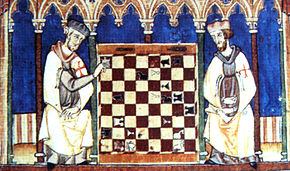
Xiangqi is the form of chess best known in China. The eastern migration of chess, into China and Southeast Asia, has even less documentation than its migration west, making it largely conjectured. The word xiàngqí (象棋) was used in China to refer to a game from 569 A.D. at the latest, but it has not been proven if this game was or was not directly related to chess.[57][58] The first reference to Chinese chess appears in a book entitled Xuánguaì Lù (玄怪錄; "Record of the Mysterious and Strange"), dating to about 800. A minority view holds that Western chess arose from xiàngqí or one of its predecessors.[59][60] Chess historians Jean-Louis Cazaux and Rick Knowlton contend that xiangqi's intrinsic characteristics make it easier to construct an evolutionary path from China to India/Persia than the opposite direction.[61]
The oldest archaeological chess artifacts – ivory pieces – were excavated in ancient Afrasiab, today's Samarkand, in Uzbekistan, Central Asia, and date to about 760, with some of them possibly being older. Remarkably, almost all findings of the oldest pieces come from along the Silk Road, from the former regions of the Tarim Basin (today's Xinjiang in China), Transoxiana, Sogdiana, Bactria, Gandhara, to Iran on one end and to India through Kashmir on the other.[62]
The game reached Western Europe and Russia via at least three routes, the earliest being in the ninth century. By the year 1000, it had spread throughout both the Muslim Iberia and Latin Europe.[63] A Latin poem called Versus de scachis ("Verses on Chess") dated to the late 10th century, has been preserved at Einsiedeln Abbey in Switzerland.
1200–1700: Origins of the modern game
The game of chess was then played and known in all European countries. A famous 13th-century Spanish manuscript covering chess, backgammon, and dice is known as the Libro de los juegos, which is the earliest European treatise on chess as well as being the oldest document on European tables games.[64] The rules were fundamentally similar to those of the Arabic shatranj. The differences were mostly in the use of a checkered board instead of a plain monochrome board used by Arabs and the habit of allowing some or all pawns to make an initial double step. In some regions, the queen, which had replaced the wazir, or the king could also make an initial two-square leap under some conditions.[65]
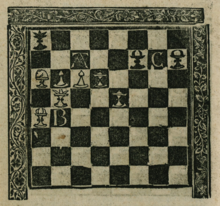
Around 1200, the rules of shatranj started to be modified in Europe, culminating, several major changes later, in the emergence of modern chess practically as it is known today.[66] A major change was the modern piece movement rules, which began to appear in intellectual circles in Valencia, Spain, around 1475,[note 4] which established the foundations and brought it very close to current chess. These new rules then were quickly adopted in Italy and Southern France before diffusing into the rest of Europe.[69][70] Pawns gained the ability to advance two squares on their first move, while bishops and queens acquired their modern movement powers. The queen replaced the earlier vizier chess piece toward the end of the 10th century and by the 15th century had become the most powerful piece;[71] in light of that, modern chess was often referred to at the time as "Queen's Chess" or "Mad Queen Chess".[72] Castling, derived from the "king's leap", usually in combination with a pawn or rook move to bring the king to safety, was introduced. These new rules quickly spread throughout Western Europe.
Writings about chess theory began to appear in the late 15th century. An anonymous treatise on chess of 1490 with the first part containing some openings and the second 30 endgames is deposited in the library of the University of Göttingen.[73] The book El Libro dels jochs partitis dels schachs en nombre de 100 was written by Francesc Vicent in Segorbe in 1495, but no copy of this work has survived.[73] The Repetición de Amores y Arte de Ajedrez (Repetition of Love and the Art of Playing Chess) by Spanish churchman Luis Ramírez de Lucena was published in Salamanca in 1497.[70] Lucena and later masters like Portuguese Pedro Damiano, Italians Giovanni Leonardo Di Bona, Giulio Cesare Polerio and Gioachino Greco, and Spanish bishop Ruy López de Segura developed elements of opening theory and started to analyze simple endgames.
1700–1873: Romantic era

In the 18th century, the center of European chess life moved from Southern Europe to mainland France. The two most important French masters were François-André Danican Philidor, a musician by profession, who discovered the importance of pawns for chess strategy, and later Louis-Charles Mahé de La Bourdonnais, who won a famous series of matches against Irish master Alexander McDonnell in 1834.[74] Centers of chess activity in this period were coffee houses in major European cities like Café de la Régence in Paris and Simpson's Divan in London.[75][76]
At the same time, the intellectual movement of romanticism had had a far-reaching impact on chess, with aesthetics and tactical beauty being held in higher regard than objective soundness and strategic planning. As a result, virtually all games began with the Open Game, and it was considered unsportsmanlike to decline gambits that invited tactical play such as the King's Gambit and the Evans Gambit.[77] This chess philosophy is known as Romantic chess, and a sharp, tactical style consistent with the principles of chess romanticism was predominant until the late 19th century.[78]
The rules concerning stalemate were finalized in the early 19th century. Also in the 19th century, the convention that White moves first was established (formerly either White or Black could move first). Finally, the rules around castling and en passant captures were standardized – variations in these rules persisted in Italy until the late 19th century. The resulting standard game is sometimes referred to as Western chess[79] or international chess,[80] particularly in Asia where other games of the chess family such as xiangqi are prevalent. Since the 19th century, the only rule changes, such as the establishment of the correct procedure for claiming a draw by repetition, have been technical in nature.
Zdroj:https://en.wikipedia.org?pojem=ChessText je dostupný za podmienok Creative Commons Attribution/Share-Alike License 3.0 Unported; prípadne za ďalších podmienok. Podrobnejšie informácie nájdete na stránke Podmienky použitia.
Antropológia
Aplikované vedy
Bibliometria
Dejiny vedy
Encyklopédie
Filozofia vedy
Forenzné vedy
Humanitné vedy
Knižničná veda
Kryogenika
Kryptológia
Kulturológia
Literárna veda
Medzidisciplinárne oblasti
Metódy kvantitatívnej analýzy
Metavedy
Metodika
Text je dostupný za podmienok Creative
Commons Attribution/Share-Alike License 3.0 Unported; prípadne za ďalších
podmienok.
Podrobnejšie informácie nájdete na stránke Podmienky
použitia.
www.astronomia.sk | www.biologia.sk | www.botanika.sk | www.dejiny.sk | www.economy.sk | www.elektrotechnika.sk | www.estetika.sk | www.farmakologia.sk | www.filozofia.sk | Fyzika | www.futurologia.sk | www.genetika.sk | www.chemia.sk | www.lingvistika.sk | www.politologia.sk | www.psychologia.sk | www.sexuologia.sk | www.sociologia.sk | www.veda.sk I www.zoologia.sk




